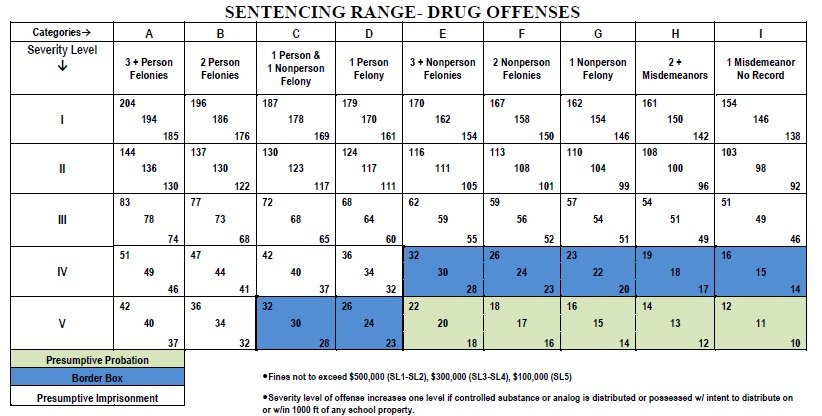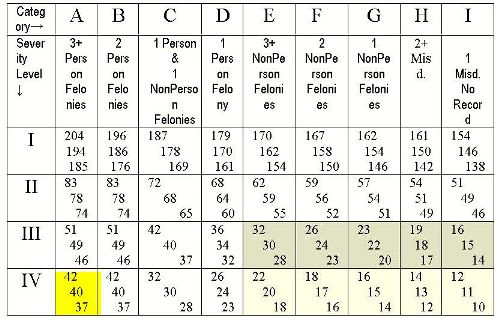|
Possession of Cocaine or Methamphetamine
Possession of cocaine or possession of methamphetamine is a Level Four drug felony punishable by a maximum prison sentence of 42 months and a maximum fine of $100,000. This is simple possession without any allegations of manufacturing, selling or distributing. The Kansas Statute that makes this illegal is K.S.A. 65-4160(a). (This statute is not the one that controls marijuana.) Everyone charged with simple possession should request their attorney inquire whether they are eligle for the court's mandatory drug treatment program under Kansas Senate Bill 123. Chances are good that if the person charged has little or no criminal history they will at least be eligible for probation if not the drug treatment program.
Included below is a drug sentencing grid that shows the range of punishment along the Level 4 row with 42 months being the maximum.
The Kansas legislature has adopted a new 5 row drug sentencing grid, but the punishment levels for simple possession remain the same with a 42 month maximum sentence. The current Kansas drug sentencing grid is depicted below and as you can see the punishment ranges from the old level four are the exact same for the new level five. Older crimes are still punished off the old grid. 
For those interested, the specific charging statute, which makes possession of cocaine and methampehetamine illegal, it is spelled out as follows: 65-4160. Unlawful acts relating to possession of opiates, opium, narcotic drugs or designated stimulants; penalties. (a) Except as authorized by the uniform controlled substances act, it shall be unlawful for any person to possess or have under such person's control any opiates, opium or narcotic drugs, or any stimulant designated in subsection (d)(1), (d)(3) or (f)(1) of K.S.A. 65-4107 and amendments thereto. Any person who violates this subsection shall be guilty of a drug severity level 4 felony. (b) It shall not be a defense to charges arising under this section that the defendant was acting in an agency relationship on behalf of any other party in a transaction involving a controlled substance. (c) For purposes of the uniform controlled substances act, the prohibitions contained in this section shall apply to controlled substance analogs as defined in subsection (bb) of K.S.A. 65-4101 and amendments thereto. (d) The provisions of this section shall be part of and supplemental to the uniform controlled substances act.
This law has been re-codified such that it is now found under K.S.A. 21-5706, though the wording remains the same. Possession of Drug Precursors or IngredientsK.S.A. 21-5709 makes it illegal to possess certain precursors or ingredients used to make other drugs, namely methamphetamine. This statute was designed to stop the manufacture of methamphetamine but occasionally we see an elderly lady with a flock of grandchildren purchasing cold medicine get caught in this net as the pharmacies are mandated to report the sale of the ingredients to the police. The prohibited ingredients are: ephedrine, pseudoephedrine, red phosphorus, lithium metal, sodium metal, iodine, anhydrous ammonia, pressurized ammonia or phenylpropanolamine, or their salts, isomers or salts of isomers with an intent to use the product to manufacture a controlled substance. Violation of this section of the statute is considered a level 3 drug crime and is punishable by a maximum prison term of 83 months with no opportunity for probation. Anhydrous ammonia or pressurized ammonia must be in a container approved for that chemical by the Kansas department of agriculture to avoid prosecution under this statute. The purchase of cold medications must be minimal to avoid prosecution under this statute. The purchase limits are as follows: 3.6 grams of pseudoephedrine base or ephedrine base in any single transaction or any compound, mixture or preparation containing more than nine grams of pseudoephedrine base or ephedrine base within any 30-day period. Violation of this section of the statute is a Class A mon-person misdemeanor punishable by a maximum jail term of 12 months.
Possession of MarijuanaWhile other states are legalizing marijuana, Kansas is going in the opposite direction. For the first charge, possession of marijuana will still be considered a class A, non-person misdemeanor, which carries a maximum punishment of 12 months jail time. However, for those with at least one prior conviction the charge will be increased to a felony under K.S.A. 21-5706 and sentenced accordingly. This crime carries a maximum 42 month imprisonment sentence. Possession of Drug ParaphernaliaUse or possession with intent to use drug paraphernalia is a class A non-person misdemeanor under Kansas law under K.S.A. 21-36a09.b.2. The statute contains an enormously long laundry list of what can be defined as drug paraphernalia in violation of this statute. Some examples of drug paraphernalia include the following: "Drug paraphernalia" means all equipment and materials of any kind which are used, or primarily intended or designed for use in planting, propagating, cultivating, growing, harvesting, manufacturing, compounding, converting, producing, processing, preparing, testing, analyzing, packaging, repackaging, storing, containing, concealing, injecting, ingesting, inhaling or otherwise introducing into the human body a controlled substance and in violation of this act. "Drug paraphernalia" shall include, but is not limited to: (1) Kits used or intended for use in planting, propagating, cultivating, growing or harvesting any species of plant which is a controlled substance or from which a controlled substance can be derived;
(2) kits used or intended for use in manufacturing, compounding, converting, producing, processing or preparing controlled substances; (3) isomerization devices used or intended for use in increasing the potency of any species of plant which is a controlled substance; (4) testing equipment used or intended for use in identifying or in analyzing the strength, effectiveness or purity of controlled substances; (5) scales and balances used or intended for use in weighing or measuring controlled substances; (6) diluents and adulterants, including, but not limited to, quinine hydrochloride, mannitol, mannite, dextrose and lactose, which are used or intended for use in cutting controlled substances; (7) separation gins and sifters used or intended for use in removing twigs and seeds from or otherwise cleaning or refining marijuana; (8) blenders, bowls, containers, spoons and mixing devices used or intended for use in compounding controlled substances; (9) capsules, balloons, envelopes, bags and other containers used or intended for use in packaging small quantities of controlled substances; (10) containers and other objects used or intended for use in storing or concealing controlled substances;
(11) hypodermic syringes, needles and other objects used or intended for use in parenterally injecting controlled substances into the human body;
(12) objects used or primarily intended or designed for use in ingesting, inhaling or otherwise introducing marijuana, cocaine, hashish, hashish oil, phencyclidine (PCP), methamphetamine or amphetamine into the human body, such as: (A) Metal, wooden, acrylic, glass, stone, plastic or ceramic pipes with or without screens, permanent screens, hashish heads or punctured metal bowls; (B) water pipes, bongs or smoking pipes designed to draw smoke through water or another cooling device; (C) carburetion pipes, glass or other heat resistant tubes or any other device used or intended to be used, designed to be used to cause vaporization of a controlled substance for inhalation; (D) smoking and carburetion masks; (E) roach clips, objects used to hold burning material, such as a marijuana cigarette, that has become too small or too short to be held in the hand; (F) miniature cocaine spoons and cocaine vials; (G) chamber smoking pipes; (H) carburetor smoking pipes; (I) electric smoking pipes; (J) air-driven smoking pipes; (K) chillums; (L) bongs; (M) ice pipes or chillers; (N) any smoking pipe manufactured to disguise its intended purpose; (O) wired cigarette papers; or (P) cocaine freebase kits.
K.S.A. 21-5706 Unlawful Drug Possession
|
